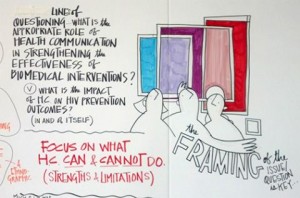HIV Experts Debate Methods to Measure SBCC Impact
 Measurement and methods were the focus of the second day of HC3’s consultation on demonstrating the impact of social and behavior change communication (SBCC) on HIV prevention outcomes.
Measurement and methods were the focus of the second day of HC3’s consultation on demonstrating the impact of social and behavior change communication (SBCC) on HIV prevention outcomes.
Experts agreed that much of the most compelling evidence regarding the effectiveness of SBCC on HIV prevention outcomes comes from data from observational or ecological study designs. The credibility of both these designs has been called into question in various circles. Experts then broke into groups to discuss alternative study designs and ways to increase the credibility of the types of study designs that are used to evaluate the impact of SBCC.
A number of recommendations were then debated in the plenary, including the need to utilize random assignment as interventions are implemented, as well as ideas for other methods, such as propensity score matching and structural equation modeling to demonstrate impact.
In addition to debating various methods, experts suggested that there is a need to harness the power of SBCC in biomedical interventions. For example, SBCC can be used to create demand for HIV testing and counseling as well as voluntary medical male circumcision, and on the supply side, can play a role in increasing the adherence of anti-retroviral medication.
Looking ahead, social and behavioral researchers and implementers have the opportunity to continue to enhance the effects of biomedical approaches, and there is a need to document the added impact that SBCC can play in these types of interventions.





Leave a Reply
Want to join the discussion?Feel free to contribute!